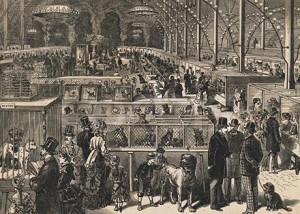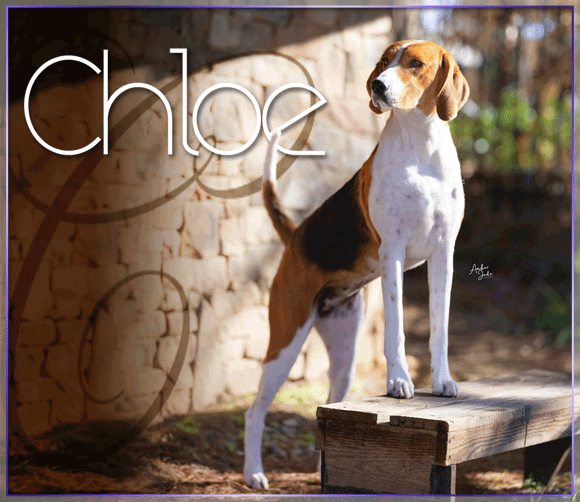From The CC Vault: The First Dog Show
By Amy Fernandez
Originally published: September 2015
 Anyone acquainted with our sport knows that the first dog show happened in 1859. However, like most conventionally accepted historical facts, the truth is kinda, sorta different.
Anyone acquainted with our sport knows that the first dog show happened in 1859. However, like most conventionally accepted historical facts, the truth is kinda, sorta different.
“The Sporting Dog Show” staged at the Town Hall, Newcastle-on-Tyne on June 28 and 29, 1859 was actually an afterthought tacked on to a wildly successful poultry show. A few decades later, historian Edward Ash profiled this momentous event for his satirical overview Dog Shows and Doggy People. “They do not appear to have been unduly venturesome, as the breeds were restricted to Pointers and Setters.” That wasn’t the only exclusive aspect of it. The Pointer arbiters coincidentally came out on top in the Setter ring. Likewise, the Setter judges grabbed the top awards in Pointers.
Despite that apparent conflict of interest, 60 contenders vied for very enticing prizes, a pair of custom made double-barreled shotguns, manufactured and donated by celebrated Newcastle gunsmith, Mr. W.R. Pape, one of the show’s principal promoters. Both he and his fellow committee member, Mr. J. Shorthose, later claimed credit for hatching the plan. Pape was described as a successful breeder, exhibitor and judge of Pointers and Setters, which qualified as a truly remarkable accomplishment considering that this was the first show!
Equally convincing anecdotal evidence credits Dr. J.H. Walsh (Stonehenge) and/or General Hutchinson, author of the 1847 bestseller, Dog Breaking, and another gunsmith, Mr. Josh Lang.
We’ll never know for sure., but we do know that years of letter writing, editorializing, and furious debate preceded the actualization of that legendary show. Pardon the pun, but no one was jumping the gun on this one as Britain’s beloved Tailwagger Magazine confirmed in 1930. “There had been two or three previous attempts to hold a show for dogs, but support had not been forthcoming, and the idea had been given up as impracticable. Many people pointed out the utter absurdity of expecting people to pay to see dogs – when they saw as many or more than they wanted, in the streets!”
Still, when it finally happened it was a blockbuster. Regardless of who originated the idea, these Gundog fanciers were on a roll, quickly organizing an expanded show later that year that also featured Retrievers, Clumbers and Cockers. And as they say, the rest is history.
But while all that was in the works, across town another doggy set was well into the second decade of their version of dog shows. The most successful of these ventures was the Toy Dog Club, England’s second official dog club, pioneered by Charles Aistrop, former proprietor of the Westminster Pit in Duck Lane. He launched his Fancy Dog Show in 1852, and despite the sixpence gate fee and socially questionable venue, a Denmark Street tavern, it was a hit from the get-go. Crowds lined up to glimpse the finest examples of exotic breeds like Blenheim Spaniels, Italian Greyhounds, Chinese Pugs, Skye Terriers, Bulldogs, and tiny Black and Tan Terriers.
In April 1990 The Kennel Gazette confirmed the longstanding history of this working class English hobby, “Formerly, interest in toy and exotic breeds had been confined to the aristocracy, but now they were to be found in even the most humble homes. As the popularity of these breeds spread it was inevitable that their owners should gather together to share their enthusiasm and extend their knowledge. One such meeting was advertised in the February 1834 issue of the Sporting Magazine.”
Along with daily coverage of coursing, racing, and prizefighting, sports rags like Bell’s Life regularly advertised a calendar of pub shows. By 1867, they were incredibly popular as James Greenwood acknowledged in his colorfully gritty chronicles of Victorian London Unsentimental Journeys; or Byways of the Modern Babylon. “At least fifty different slums and corners, and crooked ways of the great City, establishments are devoted to the ‘showing’ of dogs. The columns of Bell’s Life revealed more than a dozen invitations of the sort …the following is a fair sample: A Treat for the Fancy! – On Sunday evening next a Show will be held at Mr. Lerinke’s, ‘Duck,’ Bethnal Green-chair taken at eight o’clock.”
Greenwood arrived to find over 50 dogs meticulously groomed for display by their owners. “One could not help reflecting, after gazing first on the dog, then on its keeper, what a pity it was that the former should be tied to such a low-bred companion! How did these beautiful little creatures come into the hands of their present owners, is a question little less difficult to answer than another. Of what use are they to their masters?”
Within a few years, no one would question the motivation to cultivate a breed for purely aesthetic satisfaction. But long before shows went mainstream these quirky little events set the precedent for that concept.
Decades later, Britain’s Gundog clique battled for recognition of that honor. Although that historical detail remains open to debate, it’s fair to say that their milestone 1859 show possessed the social cachet to earn mainstream credibility for the sport.
In less than a year, shows proliferated throughout Britain and gained traction in America.
Short URL: http://caninechronicle.com/?p=250746
Comments are closed












